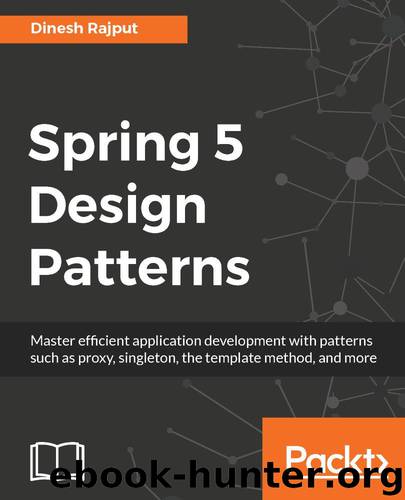Spring 5 Design Patterns: Master efficient application development with patterns such as proxy, singleton, the template method, and more by Dinesh Rajput

Author:Dinesh Rajput [Rajput, Dinesh]
Language: eng
Format: azw3
Tags: COM051240 - COMPUTERS / Software Development and Engineering / Systems Analysis and Design, COM051440 - COMPUTERS / Software Development and Engineering / Tools, COM051280 - COMPUTERS / Programming Languages / Java
Publisher: Packt Publishing
Published: 2017-10-06T04:00:00+00:00
Let's see how we will implement these cross-cutting concerns in our application by using aspects of Spring AOP.
What is Aspect-Oriented Programming?
As mentioned earlier, Aspect-Oriented Programming (AOP) enables modularization of cross-cutting concerns. It complements Object-oriented programming (OOP) which is another programing paradigm. OOP has class and object as key elements but AOP has aspect as key element. Aspects allow you to modularize some functionality across the application at multiple points. This type of functionality is known as cross-cutting concerns. For example, security is one of the cross-cutting concerns in the application, because we have to apply it at multiple methods where we want security. Similarly, transaction and logging are also cross-cutting concerns for the application and many more. Let's see in the following figure how these concerns are applied to the business modules:
Download
This site does not store any files on its server. We only index and link to content provided by other sites. Please contact the content providers to delete copyright contents if any and email us, we'll remove relevant links or contents immediately.
Hello! Python by Anthony Briggs(10116)
The Mikado Method by Ola Ellnestam Daniel Brolund(10007)
OCA Java SE 8 Programmer I Certification Guide by Mala Gupta(9977)
Algorithms of the Intelligent Web by Haralambos Marmanis;Dmitry Babenko(8519)
Sass and Compass in Action by Wynn Netherland Nathan Weizenbaum Chris Eppstein Brandon Mathis(7912)
Grails in Action by Glen Smith Peter Ledbrook(7878)
Test-Driven iOS Development with Swift 4 by Dominik Hauser(7848)
The Well-Grounded Java Developer by Benjamin J. Evans Martijn Verburg(7765)
Windows APT Warfare by Sheng-Hao Ma(7440)
Layered Design for Ruby on Rails Applications by Vladimir Dementyev(7193)
Blueprints Visual Scripting for Unreal Engine 5 - Third Edition by Marcos Romero & Brenden Sewell(7072)
Secrets of the JavaScript Ninja by John Resig Bear Bibeault(6629)
Kotlin in Action by Dmitry Jemerov(5293)
Hands-On Full-Stack Web Development with GraphQL and React by Sebastian Grebe(4379)
Solidity Programming Essentials by Ritesh Modi(4350)
WordPress Plugin Development Cookbook by Yannick Lefebvre(4168)
Functional Programming in JavaScript by Mantyla Dan(4121)
Unity 3D Game Development by Anthony Davis & Travis Baptiste & Russell Craig & Ryan Stunkel(4080)
The Ultimate iOS Interview Playbook by Avi Tsadok(4050)
